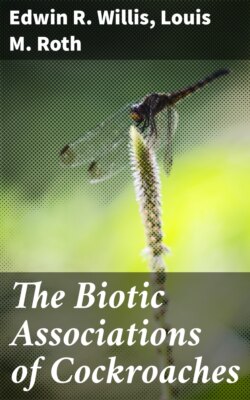Читать книгу The Biotic Associations of Cockroaches - Edwin R. Willis - Страница 13
На сайте Литреса книга снята с продажи.
CAVE HABITATS
ОглавлениеTable of Contents
Caves, mines, and animal burrows are somewhat similar habitats that provide many species of cockroaches with shelter and frequently with food. The microclimates of these cockroach habitats have not been described in detail in the papers cited, but it seems rather obvious that natural caves, man-made caves (mines), and burrows offer relatively stable temperatures and humidities and protection from adverse climatic conditions. Although such cavernicolous animals as birds and bats periodically leave caves to search for food, cockroaches find the accumulated guano and animal and plant detritus an entirely adequate dietary (Chopard, 1938). Cockroaches in mines presumably subsist on the food and feces dropped by man and mine animals (e.g., pit ponies). Food stored in their nests by burrowing animals is undoubtedly utilized by the associated cockroaches.
Cavernicolous cockroaches show varying degrees of dependence on and adaptation to these specialized habitats. Some of the common domiciliary species (Blatta orientalis, Blattella germanica, and Periplaneta americana) may have accompanied man into caves and remained there after he left (Chopard, 1929a, 1936, 1938). Other species, from the paucity of records noting their occurrence in caves, are undoubtedly accidental inhabitants that may never become established. Besides these, however, many other species of cockroaches have established large breeding colonies in caves. Although some of the latter species show very pronounced morphological adaptations to a cave life, many others resemble their noncavernicolous relatives. The possible origin of cavernicolous Orthoptera has been discussed by Chopard (1938).
Cavernicolous cockroaches have been segregated into four groups according to their ability to adapt to their environment and the degree of their specialized evolution (Chopard, 1936, 1938): (1) Trogloxenes: Cockroaches that occur in caves in a sporadic fashion (the domiciliary cockroaches and accidentals such as Ectobius and Heterogamodes). (2) Troglophiles: Cockroaches found habitually in caves (Symploce, Periplaneta cavernicola). (3) Guanobies: Cockroaches that live in the guano of cavernicolous vertebrates (Gyna, Acanthogyna, Dyscologamia, Pycnoscelus). (4) Troglobies: Cockroaches that apparently cannot live outside of caves and which show very marked adaptive characters (Alluaudellina, Nocticola, Spelaeoblatta, Typhloblatta). For complete discussions of these groups including descriptions of the adaptive characters shown by certain genera, the original sources should be consulted.
Although we know very little of the ethology of most of the cavernicolous cockroaches, it is intriguing that three of the six known species of Nocticola are cave dwellers, two are inhabitants of termite nests (p. 315), and one (N. bolivari) was found under stones and cement blocks (Chopard, 1950b). In the rather extensive list of cavernicolous cockroaches only two (Arenivaga grata and Parcoblatta sp.) were taken from caves in North America north of Yucatan. All other records are from Africa, Asia, Central America, Europe, West Indies, East Indies, and the Philippine Islands. This we find puzzling. Packard (1888) in his extensive study of the cave fauna of North America listed no cockroaches. Dearolf (1941) found only the above-mentioned Parcoblatta in one of 37 caves in Pennsylvania. Kohls and Jellison (1948) listed no cockroaches among the arthropods from six bat caves in Texas. We would expect Periplaneta americana to inhabit mines in North America, but we have found no such records. Have cockroaches been ignored in fauna collections from North American caves, or has our cave fauna been less extensively studied than that of other parts of the world?
The two species of cockroaches found in mines (Blattella germanica and Periplaneta americana) are also found in caves. For this reason we have included them in the list headed Cavernicolous Cockroaches. On the other hand, the cockroaches found in animal burrows are generally different species from those found in caves, so we have grouped these together in a second list.
